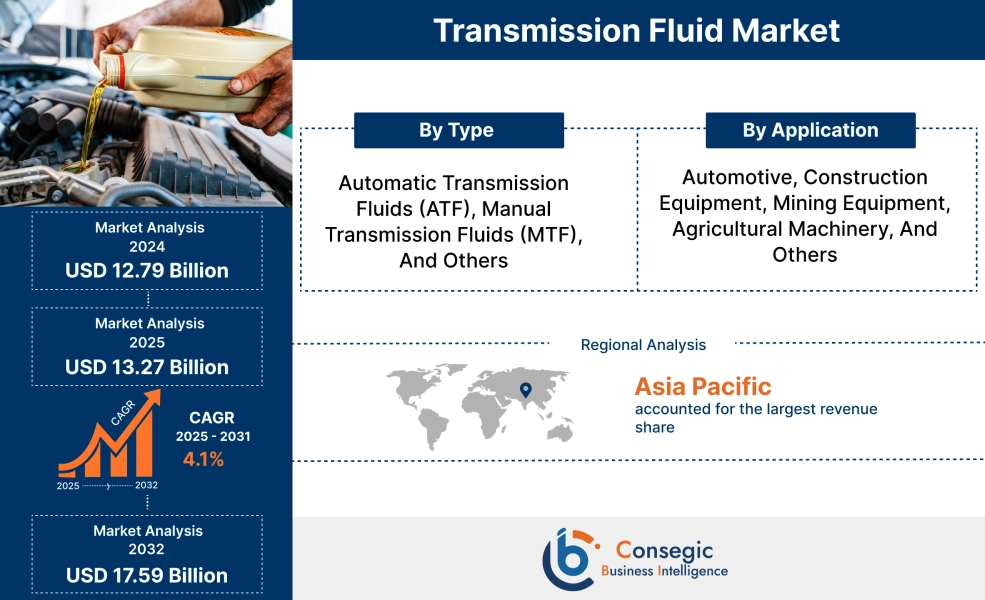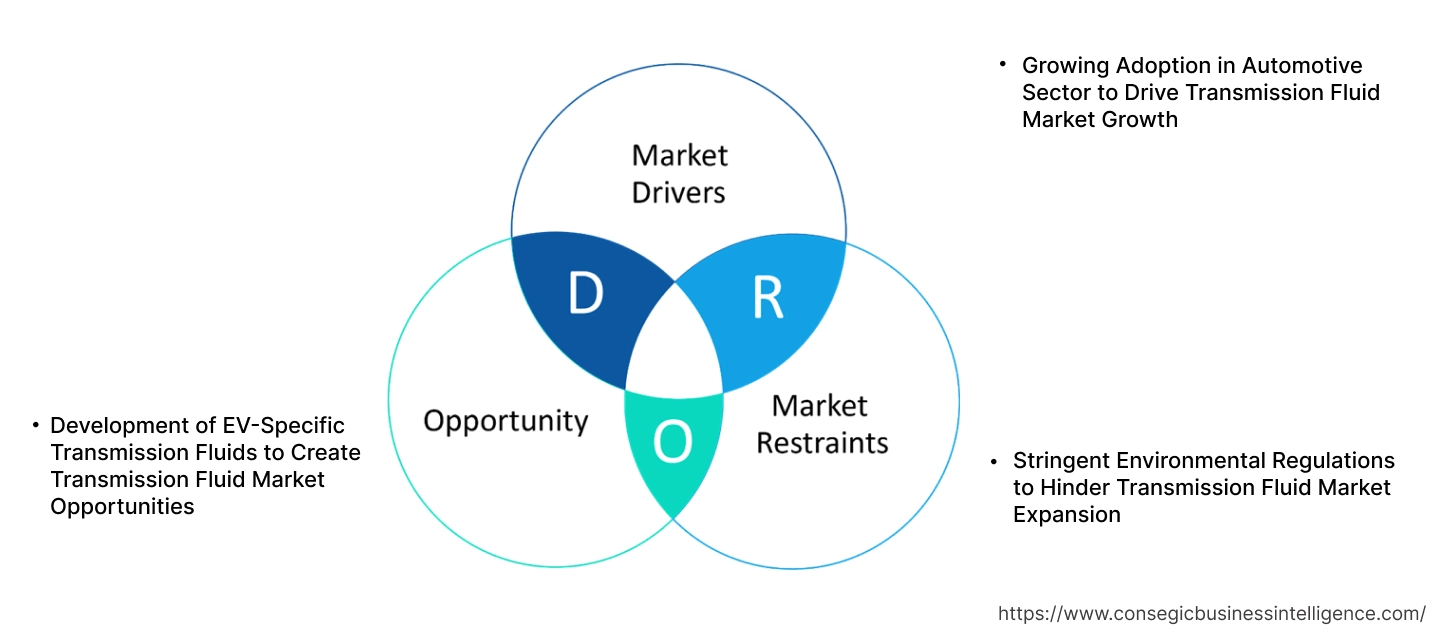Transmission Fluid Market Size:
The Transmission Fluid Market size is growing with a CAGR of 4.1% during the forecast period (2025-2032), and the market is projected to be valued at USD 17.59 Billion by 2032 from USD 12.79 Billion in 2024. Additionally, the market value for 2025 is attributed to USD 13.27 Billion.
Transmission Fluid Market Scope & Overview:
Transmission fluid is a specialized lubricant developed for the optimal functioning of a vehicle's transmission system. It serves multiple critical roles, including lubricating the intricate moving parts to minimize friction and wear, effectively dissipating heat generated during operation to prevent overheating, and acting as a hydraulic medium in automatic transmissions to facilitate power transfer and smooth gear engagement. Furthermore, it contributes to maintaining the integrity of seals and contains additives that clean and protect metal surfaces from corrosion and contaminants, thereby extending the overall lifespan and efficiency of the transmission.
How is AI Impacting the Transmission Fluid Market?
AI is influencing the transmission fluid market by enabling smarter fluid management and predictive maintenance. While AI does not directly change the chemical composition of the fluid, it leverages data from in-vehicle sensors to analyze factors like temperature, viscosity, and contamination in real-time. This allows AI-powered systems to accurately predict the optimal time for a fluid change, moving away from a fixed-interval maintenance schedule. This proactive approach not only extends the life of the transmission and the fluid itself but also reduces waste and operational costs. The result is a shift towards a more data-driven, efficient, and reliable automotive maintenance ecosystem.
Transmission Fluid Market Dynamics - (DRO) :
Key Drivers:
Growing Adoption in Automotive Sector to Drive Transmission Fluid Market Growth.
As vehicle production and sales continue to rise there's a corresponding surge in the adoption of transmission fluids, both for initial factory fills by original equipment manufacturers and for ongoing aftermarket maintenance. Additionally, continuous advancements in transmission technologies, such as the increasing popularity of automatic, continuously variable and dual-clutch systems are also supporting the demand. These sophisticated transmissions require specialized, high-performance fluids that ensure smooth operation, enhance fuel efficiency, and extend the lifespan of intricate components, thus directly fueling market within the automotive industry.
- For instance, according to the data published by ACEA, the European Union manufactured 12.2 million cars in 2023, marking an 11.6% increase compared to 2022 production figures.
Thus, as per the analysis, the growing market for these fluids in the automotive sector is fueling significant transmission fluid market growth.
Key Restraints:
Stringent Environmental Regulations to Hinder Transmission Fluid Market Expansion.
Stringent environmental regulations serve as a significant impediment to the transmission fluid market demand, impeding market growth. Governments and regulatory bodies are implementing stricter standards concerning vehicle emissions, fuel efficiency, and the chemical composition and disposal of automotive fluids. This pressure compels manufacturers to invest heavily in research and development to formulate fluids that contain fewer hazardous substances and contribute to lower overall vehicle emissions. This results in higher production costs for manufacturers. The need for specialized manufacturing processes, and compliance testing to meet diverse global regulations increases the final product price. Furthermore, stricter rules on the disposal and recycling of used fluids add to the operational complexities for the market. As a result, the above-mentioned factors are limiting the transmission fluid market expansion.
Future Opportunities :
Development of EV-Specific Transmission Fluids to Create Transmission Fluid Market Opportunities.
Newer advanced electric drivetrains, particularly those with multi-speed transmissions or integrated electric motor/gearbox units (e-axles), necessitate specialized fluids. These EV-specific transmission fluids, referred to as e-fluids, are engineered to meet unique performance criteria. They must provide efficient thermal management for electric motors and batteries, offer excellent electrical insulation to prevent short circuits, ensure optimal lubrication for gears and bearings under high-speed and high-torque conditions, and exhibit compatibility with novel materials present in EV powertrains. The rapid growth of the global EV market, driven by environmental regulations and consumer demand, directly translates into a growing market for these specialized e-fluids, presenting a lucrative avenue for lubricant manufacturers to innovate and expand their product portfolios.
- For instance, in 2024, Castrol expanded its Castrol ON range with the launch of two new high-performance, fully synthetic EV-specific transmission fluids, Castrol ON EV Transmission Fluid W2 and W5, developed through collaborations with MG Motor and BYD respectively, to optimize efficiency, longevity, and protection for wet e-motors while also being compatible with dry e-motor systems in some cases, building on their earlier D1 and D2 offerings for dry e-motors.
Henceforth, the aforementioned factors are creating lucrative transmission fluid market opportunities over the forecast period.
Transmission Fluid Market Segmental Analysis :
By Type:
Based on type, the market is categorized into automatic transmission fluids (ATF), manual transmission fluids (MTF), and others.
Trends in Type:
- A growing shift towards synthetic and semi-synthetic ATFs for extended drain intervals and superior performance is a key trend.
- Trend of the development of lighter-weight MTFs to improve shifting feel and fuel economy is rising.
The automatic transmission fluids (ATF) segment accounted for the largest transmission fluid market share in 2024.
- Automatic Transmission Fluids (ATF) are highly complex, specialized hydraulic fluids designed for vehicles equipped with automatic transmissions.
- Their role includes lubricating gears and bearings to minimize wear, efficiently transferring power through the torque converter, actively cooling the transmission to prevent overheating, and maintaining the integrity of crucial seals.
- The primary driver for this segment's dominance is the widespread global adoption of automatic transmissions in passenger cars and light commercial vehicles along with the continuous advancements in automatic transmission technology.
- For instance, in 2025, Lubrizol unveiled Lubrizol AT9311, a new multi-vehicle ATF additive for passenger cars that offers enhanced fuel economy and extended drain intervals for both traditional and hybrid vehicles.
- Thus, as per the transmission fluid market analysis, the ATF segment is dominating the transmission fluid market demand.
Others segment is expected to grow at the fastest CAGR over the forecast period.
- The others segment comprises specialized fluids addressing the unique requirements of various advanced and heavy-duty applications, representing a growing niche.
- This category includes fluids for continuously variable transmissions which ensure precise friction for smooth, stepless acceleration, and dual-clutch transmission (DCT) fluids, essential for managing lubrication and enabling rapid, efficient shifts in sophisticated DCT systems.
- Furthermore, it encompasses fluids for hydrostatic transmissions in specific heavy equipment. Crucially, electric vehicle specific fluids form a rapidly emerging sub-segment, designed for the distinct needs of EV powertrains, including cooling, electrical insulation, and e-axle lubrication.
- This segment's growth is driven by the rapid technological evolution in automotive powertrains and the specific demands of heavy-duty and off-road machinery.
- Overall, considering the aforementioned factors, the other segment is expected to grow over forecast period.
By Application:
Based on application, the market is categorized into automotive, construction equipment, mining equipment, agricultural machinery, and others.
Trends in the Application:
- Automakers are increasingly specifying unique fluid requirements for their advanced multi-speed and hybrid transmissions, driving trend of highly tailored, OEM-approved fluids.
- To minimize downtime and maintenance costs, there's a growing trend towards transmission fluids with longer drain intervals for heavy construction machinery.
The automotive segment accounted for the largest transmission fluid market share of 51.23% in 2024 and is also expected to grow at fastest CAGR over the forecast period.
- This segment is the largest consumer of transmission fluids encompassing all types of road-going vehicles from light-duty passenger cars to heavy commercial vehicles such as trucks and buses.
- This significant market share is primarily driven by the continuous rise in global vehicle production and sales.
- In addition to this, the increasing complexity of modern transmissions, including advanced ATF, continuously variable transmissions, and dual-clutch transmissions systems, necessitates specialized fluid formulations.
- Stringent fuel economy and emission regulations worldwide also compel the use of high-performance fluids, while a growing emphasis on vehicle longevity and maintenance and emergence of EV-specific fluids further support the aftermarket demand.
- For instance, new IEA report indicates that global electric car sales are projected constitute over a quarter of worldwide car sales, and are on track to surpass a 40% market share by 2030.
- Thus, based on market analysis, the automotive segment is dominating market growth.
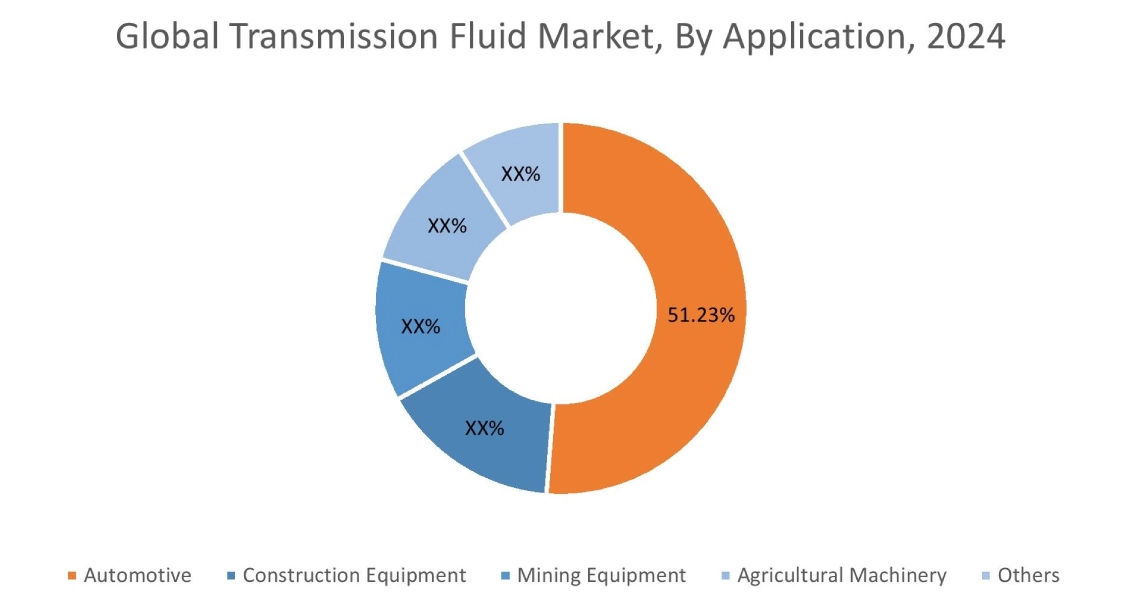
Regional Analysis:
The regional segment includes North America, Europe, Asia Pacific, the Middle East and Africa, and Latin America.
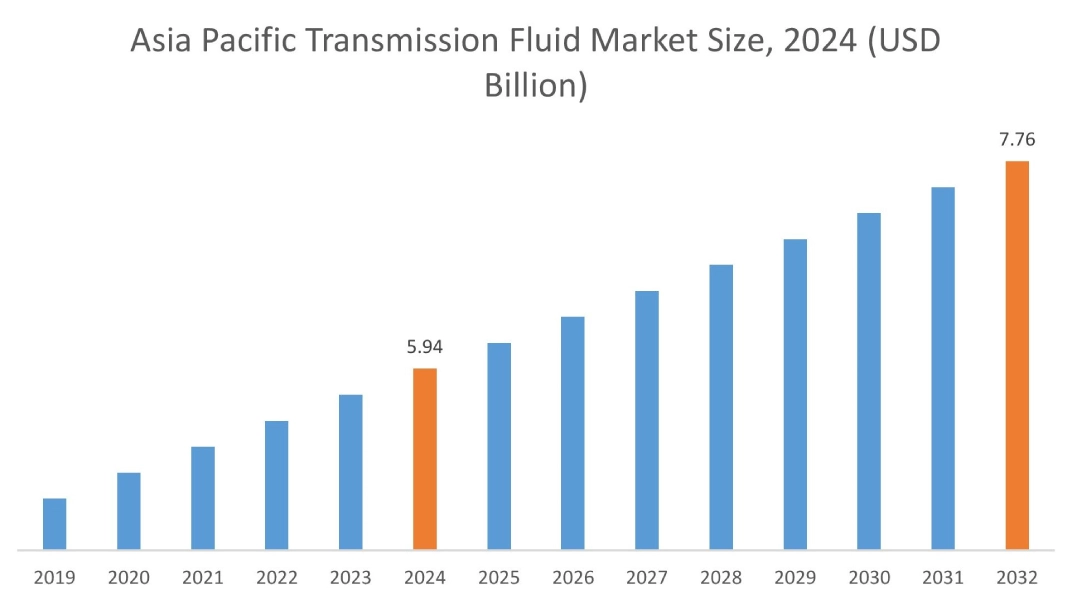
In 2024, Asia Pacific accounted for the highest market share at 46.45% and was valued at USD 5.94 Billion and is expected to reach USD 7.76 Billion in 2032. In Asia Pacific, the China accounted for a market share of 41.22% during the base year of 2024. The upwards trajectory of the region is predominantly fueled by its booming automotive sector. The region, notably comprising major automotive manufacturing hubs such as China, India, and Japan, consistently leads global vehicle production. The substantial output, driven by rising disposable incomes, rapid urbanization, and a growing middle class, directly translates into high requirement for transmission fluids for both initial factory fills in new vehicles and subsequent aftermarket maintenance. The region also sees increasing adoption in the automotive sector, particularly for electric vehicles.
- For instance, the Ministry of Heavy Industries of India introduced the PM E-DRIVE Scheme, allocating USD 1.28 billion to accelerate the growth of India's Electric Vehicle (EV) ecosystem in 2024. This initiative aims to foster electric mobility nationwide and reduce the country's dependence on fossil fuels.
Thus, as per analysis, these factors collectively position Asia Pacific as a key region for the market.
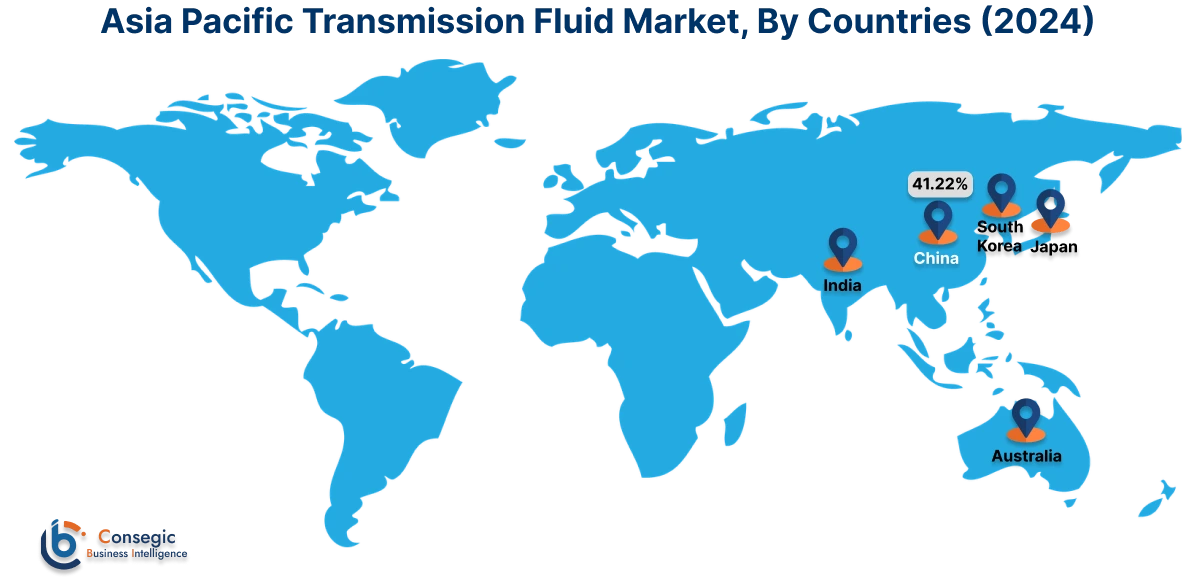
In Europe, the transmission fluid industry is experiencing the fastest growth with a CAGR of 5.6% over the forecast period owing to the region’s strong emphasis on technological innovation within its automotive industry. European manufacturers consistently push for advanced transmission systems fueling the requirement for specialized, high-performance fluids. This includes a growing focus on lower viscosity fluids to meet stringent fuel economy and emission regulations, as well as the development of highly specific OEM-approved formulations tailored for complex multi-speed automatic transmissions. Furthermore, Europe serves as a key region for the research and development of EV-specific fluids, driven by ambitious electrification targets and the increasing production of electric and hybrid vehicles, creating a distinct and rapidly evolving segment within the market. Collectively these factors fuel Europe transmission fluid market analysis.
North American market is defined by continuous advancements in transmission technologies. The region's robust automotive sector, coupled with stringent fuel economy regulations, has supported the widespread adoption of highly sophisticated transmission systems. This includes the increasing prevalence of multi-speed automatic transmissions, Continuously Variable Transmissions (CVTs), and Dual-Clutch Transmissions (DCTs) in passenger cars and light commercial vehicles. Furthermore, North America is a key region for the development and adoption of hybrid and electric vehicles. Hence, as per analysis, these factors collectively present a positive impact on the North American transmission fluid market trends.
The market in Latin America is characterized by the expansion of the off-road and heavy-duty vehicles sector. Countries across the region are undergoing increasing industrialization, infrastructure development, and agricultural modernization. This leads to a higher requirement for heavy commercial vehicles, construction equipment including excavators and loaders, and a range of agricultural machinery such as tractors and harvesters. These demanding applications require robust, high-performance transmission fluids that withstand extreme operating conditions, heavy loads, and continuous use, ensuring equipment longevity and minimizing costly downtime. Consequently, as these sectors continue to expand, the market for specialized lubricants tailored to the needs of these strenuous applications sees a corresponding increase in demand throughout Latin America.
The transmission fluid market trend in the Middle East and Africa is characterized by increasing vehicle ownership and extensive infrastructure development. The surge in car sales, particularly of new and used passenger cars, directly fuels demand for lubricants, both for initial factory filters and for regular aftermarket servicing throughout the vehicles' lifecycles. Concurrently, governments in the Middle East and Africa are heavily investing in large-scale infrastructure projects, including new roads, railways, airports, and major urban developments. These undertakings drive the demand for heavy-duty construction, mining, and agricultural machinery, all of which require robust, high-performance transmission fluids to ensure operational efficiency, durability, and minimal downtime in demanding working environments.
Top Key Players and Market Share Insights:
The Global Transmission Fluid Market is highly competitive with major players providing products to the national and international markets. Key players are adopting several strategies in research and development (R&D) and product innovation to hold a strong position in the global Transmission Fluid market. Key players in the Transmission Fluid industry include
- ExxonMobil Corporation (U.S.)
- Shell plc (UK)
- MPM International Oil Company B.V. (Netherlands)
- BASF (Germany)
- Idemitsu Kosan Co., Ltd. (Japan)
- Castrol Limited (UK)
- TotalEnergies SE (France)
- Chevron Corporation (U.S.)
- FUCHS (Germany)
- Valvoline Inc. (U.S.)
Transmission Fluid Market Report Insights :
| Report Attributes | Report Details |
| Study Timeline | 2019-2032 |
| Market Size in 2032 | USD 17.59 Billion |
| CAGR (2025-2032) | 4.1% |
| By Type |
|
| By Application |
|
| By Region |
|
| Key Players |
|
| North America | U.S. Canada Mexico |
| Europe | U.K. Germany France Spain Italy Russia Benelux Rest of Europe |
| APAC | China South Korea Japan India Australia ASEAN Rest of Asia-Pacific |
| Middle East and Africa | GCC Turkey South Africa Rest of MEA |
| LATAM | Brazil Argentina Chile Rest of LATAM |
| Report Coverage |
|
Key Questions Answered in the Report
How big is the Transmission Fluid market? +
In 2024, the Transmission Fluid market is USD 12.79 Billion.
Which is the fastest-growing region in the Transmission Fluid market? +
Europe is the fastest-growing region in the Transmission Fluid market.
What specific segmentation details are covered in the Transmission Fluid market? +
By Type and Application segmentation details are covered in the Transmission Fluid market.
Who are the major players in the Transmission Fluid market? +
ExxonMobil Corporation (U.S.), Shell plc (UK), Castrol Limited (UK), TotalEnergies SE (France), Chevron Corporation (U.S.), FUCHS (Germany) are some of the major players in the market.
